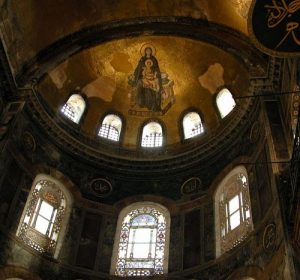Words on the Word
Mary the Mother of God
The liturgical year gives us several thematic feasts dedicated to the Blessed Virgin Mary. Today we honour her simple as the ‘Mother of God’. The title was ascribed to her at the Council of Ephesus in 431. It soon found expression in theology, liturgical poetry, and the arts. Ii is not uncommon, in the Christian basilicas of Antiquity, to find a mosaic of the Mother of God in the apse, above the altar, as the visual focus of the building. Uninitiated visitors (especially if they happen to be Norwegian, conditioned by the rhetoric of Reformation debates) can easily misunderstand these. They may think that believers of old practised a Marian pity that somehow put Christ in the shade.
The opposite is the case. When the Council Fathers at Ephesus solemnly called the Virgin Mary Theotokos, ‘Godbearer’, it was to put a seal on the Church’s christology. For more than a hundred years, since Nicaea, a battle had gone on to find responsible expression for the truth about Jesus Christ. Then as now, there was a tendency to conceive of him in too horizontal terms, as an exceedingly graced, attractive, lovable brother.
A truly Biblical belief in Christ – a belief like the one St Paul expresses when he asserts that in Christ ‘the fullness of Godhead dwells bodily’ (Col 2:9) – is more than our thinking can sustain. Is he a man like us and still ‘Light from Light’? How can the Father’s eternal Word be subject to the limitations of time and space that define our existence and often weigh us down?
To think theologically is demanding. We don’t much like thoughts that make demands. Instead we cook up our own notions of Christ. They’re frequently banal and dull, but possess the advantage of being instantly accessible. The question is: Do we not end up worshiping an image of own making, the fabrication of our limited ideas?
It says a lot that worship is a dimension very often absent from our life of prayer and from our liturgies. There’s a lot of talk, right now, about the Church’s various crises. To my mind, there is only one fundamental crisis of importance, given that all the rest spring from it – I mean the widespread loss of faith in Christ as the Son of God.
Our attitude to the Virgin Mary is a good indication of where we stand in this respect. It reveals what we believe to be true about Christ, what we believe to be true about ourselves. If we believe in Christ with the faith of the Church, not with a faith of our own making, the Marian mystery will open itself before us. The call to bear the Eternal into time, the Immortal into corruptibility, the Holy One into a nature scarred by sin is a call so immense that it necessarily transforms the one to whom it is entrusted. The Mother of God shows us what human being is capable of, as the embodied image of God, in its highest potential.
When she does this, it is not primarily so that we can venerate her high up on the walls of churches. She does it in order to manifest what we, by grace, are also called to become. The mystery of the incarnation continues in the Church: that is the most astonishing thing about life. Leo the Great once said: God has given to the waters of baptism what he bestowed on his Mother (‘dedit aquae quod dedit Matri’, Sermo XXV). By baptism, we have been enabled to be bearers of divine life, to partake of divine nature (2. Peter 1:4). Today’s feast honours the Virgin Mary, of course. But it also makes our own vocation explicit.
Do we believe in that vocation? Will we say yes to it and give ourselves wholly over to it? Do we desire to become, in Christ, an inspired ‘new creation’ (2 Cor 5:17) — or are we in fact well satisfied with the old and worn?

